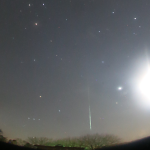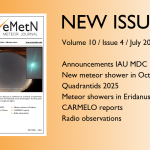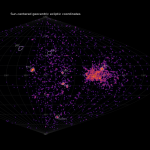Radio Meteor Observations in the World: Monthly Report in December 2016 by The International Project for Radio Meteor Observation.
Geminids 2016
One of the major meteor showers, the Geminids occurred in this month. There was no unusual acitivty during this year. The peak was estimated at around 21:30(UT) on 13th Dec. with a peak level A(max)=4.0. This activity profile was the same as it was in 2013 and 2015.

Figure 1 – using 30 observing stations in 12 countries.
You can see the detailed information on the page “Result for the Geminids 2016“.
In addition, Mr.Hirofumi Sugimoto converted from the Activity Level index to the visual ZHR. (http://www5f.biglobe.ne.jp/~hro/Flash/2016/GEM/index.html)
Ursids 2016
At the end of December, the Ursids showed a high activity around 10:30(UT) on the 22nd Dec.(Solar Longitude: 270°.78). The structure has A(max)=1.0 with FWHM=-2.0/+4.0 hours. Although a strong Ursid activity was also observed in 2014, the activity in 2016 was weaker than in 2014.

Figure 2 – using 22 observing stations in 10 countries.
You can see the more detailed information on the page “Result of Ursids 2016″. In addition, Mr.Hirofumi Sugimoto converted from the Activity Level index to the visual ZHR .
(http://www5f.biglobe.ne.jp/~hro/Flash/2016/URS/index.html)
The possible enhanced on 2nd – 3rd December
On the 2nd – 3rd of December 2016, a possible enhanced activity was predicted by J. Vaubaillon. The suspected radiant was the 66-Draconids with α=310° and δ=+64°. Although worldwide data were calculated, there was no unusual activity.
In addition, the CAMS-Network recorded some activity from the December κ Draconids with α=186° and δ=+70°(see Meteor-News). On the other hand, however, worldwide radio meteor observations did not register this activity. In the case of the Activity Level index, it is only possible to detect some meteor activity when the ZHR is more than 20-30 (depending on the geocentric velocity).

Figure 3 – using 17 observing stations in eight countries.

Figure 4 – using 17 observing stations in eight countries.
Mr.Hirofumi Sugimoto converted from the activity level index to the visual ZHR , and there was a possible very weak December κ Draconids activity. This result showed a Zenithal Hourly Rate of around 20. (http://www5f.biglobe.ne.jp/~hro/Flash/2016/DKD/)
Beside these topics, the following graph displays the monitored result (using ONLY Japanese stations) in December 2016.

Figure 5 – Monitored result for December (only Japan).
A distinct Geminid activity was observed between 10th and 15th of December. The Ursids were not clear in Japan. This is because of a low radiant elevation. There was no unusual activity except for the Geminids period.
Acknowledgement
— Radio Meteor Observing Bulletin (RMOB)
— Radio Meteor Observation in Japan (RMOJ)
— all radio meteor observers





